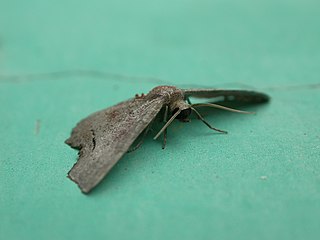
Urodidae, whose species are commonly known as false burnet moths, is a family of moths in the lepidopteran order. It is the type genus in the superfamily, Urodoidea, with three genera, one of which, Wockia, occurs in Europe.

Heliodinidae, commonly known as sun moths, is a family of small moths with slender bodies and narrow wings. Members of this family are found in most parts of the world. Heliodinid moths are brightly coloured day-flying moths. The base of the haustellum is bare. The scales on the head are compact and appear like a shield. Many Heliodinidae raise their hindlegs when resting but this is not a taxonomic feature and several genera like Epicroesa and Lamprolophus do not show this posture. Many Heliodinidae have the inner and outer spurs of the metatibia subequal. The larval host plants of the majority of species are in the Aizoaceae, Chenopodiaceae, Phytolaccaceae, Portulacaceae and Nyctaginaceae, all in the Order Caryophyllales. A few feed on Onagraceae, Araliaceae and Piperaceae. The pupae have long stiff hairs on their back sides.
Metachanda is the sole genus in tribe Metachandini of moth subfamily Oecophorinae. Metachandini was originally described as family Metachandidae by Edward Meyrick in 1911, and at the time also contained the genus Chanystis, which is currently unplaced to tribe within Oecophorinae. It has also previously been described as tribe Metachandini of subfamily Gelechiinae.
Agathiphaga is a genus of moths, known as kauri moths. and is the only living genus in the family Agathiphagidae. This caddisfly-like lineage of primitive moths was first reported by Lionel Jack Dumbleton in 1952, as a new genus of Micropterigidae.
Utriculofera is a genus of moths in the subfamily Arctiinae erected by George Hampson in 1893.

Diphtherinae is a monotypic subfamily of moths in the family Nolidae erected by Michael Fibiger and J. Donald Lafontaine in 2005. Its only genus, Diphthera, was erected by Jacob Hübner in 1809. The genus was moved from Noctuidae in 2013 after the phylogenetic analysis of Reza Zahiri et al. (2013).
Anthalma is a monotypic moth genus in the family Geometridae. Its only species, Anthalma latifasciata, is found in Panama. Both the genus and species were first described by Warren in 1901.

Blepharoctenucha is a monotypic moth genus in the family Geometridae described by Warren in 1895. Its only species, Blepharoctenucha virescens, first described by Arthur Gardiner Butler in 1880, is known from India and Taiwan.
Celonoptera is a monotypic moth genus in the family Geometridae. Its only species, Celonoptera mirificaria, is found in south-eastern Europe. Both the genus and species were first described by Julius Lederer in 1862.
Ithysia is a monotypic moth genus in the family Geometridae. Its only species is Ithysia pravata. The genus was erected by Jacob Hübner in 1825, but the species had been first described by Hübner in 1813.
Megalotica is a genus of moths in the family Geometridae described by Zimmerman in 1958.
Syzeuxis is a genus of moths in the family Geometridae erected by George Hampson in 1895.

Xenozancla is a monotypic moth genus in the family Geometridae. Its only species, Xenozancla versicolor, is found in northern India. Both the genus and species were first described by William Warren in 1893.

Tortricosia excisa is a moth in the subfamily Arctiinae first described by George Hampson in 1900. It is found in Myanmar, Peninsular Malaysia and Borneo. The habitat consists of lowland forests, including heath forests and disturbed areas.
Utriculofera aplaga is a moth in the subfamily Arctiinae. It was described by George Hampson in 1900. It is found on New Guinea and on Rossel Island in the Louisiade Archipelago.
Utriculofera fuscapex is a moth in the subfamily Arctiinae. It was described by George Hampson in 1893. It is found in Sri Lanka and India, as well as on Borneo. The habitat consists of lowland forests.
Utriculofera macroplaga is a moth in the subfamily Arctiinae. It was described by George Hampson in 1900. It is found on Borneo.
Utriculofera muricolor is a moth in the subfamily Arctiinae. It was described by Rothschild in 1913.
Utriculofera utricularia is a moth in the subfamily Arctiinae. It was described by Rothschild in 1912. It is found in New Guinea.
Utriculofera variegata is a moth in the subfamily Arctiinae. It was described by Rothschild in 1912. It is found in New Guinea.





